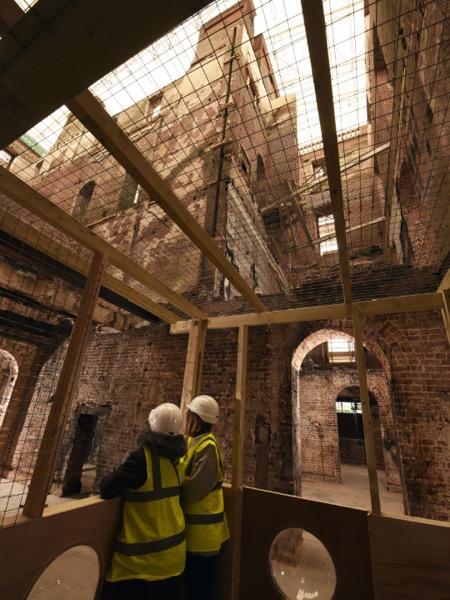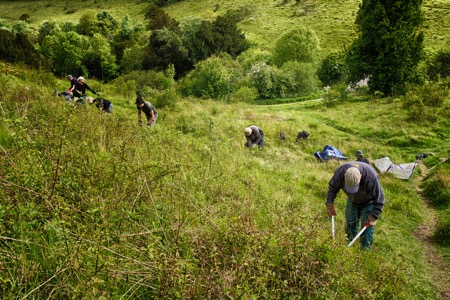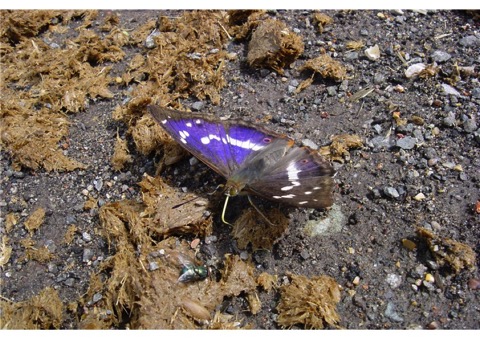National Trust
Previously-unseen spaces revealed at Clandon Park as the National Trust opens basement to visitors
04/05/18 12:46 Filed in: What's On | Clandon Park

The basement at the National Trust’s Clandon Park in Surrey is open for the first time since the 2015 fire, giving visitors a chance to delve deeper in to the house.
From today, a new walkway in to the basement takes visitors on an atmospheric journey to where the fire started, revealing its full impact on the house, as well as leading them through a new exhibition.Following the basement corridor towards the south end of the house, the new walkway takes visitors deep in to the lowest, and most fire-damaged spaces within the 18th-century Palladian mansion.
The less damaged north end of the basement will also be on show, as visitors are led to the beautiful undercroft - a vaulted room under the Marble Hall - which pre-fire visitors will remember as the restaurant. This now includes a display, charting the design challenges, and key questions, that the National Trust is considering during the hugely complex project.
Visitors are invited to share their thoughts as the National Trust works with its architects, specialist advisers and stakeholders to develop plans for Clandon’s future.
From the undercroft visitors can pass into a protected viewing area which gives them sight of the full extent of the fire damage for the first time, with dramatic, vertical views from basement floor to scaffolding roof.
Sophie Chessum, Senior Project Curator at Clandon Park says: “Sharing our progress since the fire has always been really important to us. Previous visitors to Clandon Park have been able to visit the Saloon, State Bedroom and Marble Hall, which are amongst the most significant rooms in the house and therefore areas we felt visitors should see straightaway.
“By opening up the basement, we are creating a new space for discussion about Clandon’s future in an area of the house where the extent of the damage to Clandon is at its starkest.
“This is a unique opportunity for visitors to see the extraordinary bare bones of this grand Palladian mansion, in its post-fire state, before access may become more limited further down the line when building work is underway.”
The new basement walkway adds to the existing access at Clandon Park, which includes the Saloon, State Bedroom, Marble Hall and the garden.
Clandon Park is open until 28 October 2018 (including the first May bank holiday weekend, 5-7 May).
For more information please visit www.nationaltrust.org.uk
National Trust Volunteers
23/09/15 12:56 Filed in: What's On | National Trust

The National Trust is a household name
Some would argue that the oak leaf is an intrinsic part of British culture, as familiar to you and I as a pot of tea or David Attenborough’s voice.Did you know that we are the largest voluntary conservation charity in Europe? Our moto is to protect areas of historical and ecological value for ever, for everyone. It is this need and duty to protect these fragile and irreplaceable sites which drives us forward, choosing new sites, pioneering new schemes and continuing to maintain our properties.
Membership, donations and the indomitable tea rooms all help to finance and support these efforts. However we are the largest voluntary conservation charity, the very foundation of the National Trust is built upon the loyalty and dedication of our volunteer army.
It is easy to see the National Trust as one vast charitable machine but in reality it consists of pockets of land and property, each needing its own individual regime of care and attention. Here in the Surrey Hills we are lucky to be surrounded by many such pockets, in fact just down the road is Box Hill, a beautiful and fragile mosaic of grassland and woodland. Hundreds of visitors walk, drive or cycle the world famous Zig Zag every day to take in the stunning sites and scenery that Box Hill has to offer. Box Hill has its own volunteer regiment at whose feet this beauty can be laid.
Every Wednesday and every Thursday come rain or shine, our volunteers help restore and conserve Box Hill, for both ecological reasons and for you the public to enjoy. We are always looking to expand and add to our teams, with local people, who care about nature, and who have a sense of ownership and pride at having access to Box Hill. All ages and genders are welcome, whether you are working or retired, an athlete or a dog walker, there is a space for you in our team. We need people to help keep Box Hill beautiful, the more people we have the more we can do, the bigger the projects we can embark on and the more events we can host. The more that we as a community put in, the more that we’ll get back.
The National Trust needs volunteers, the National Trust needs you!
Gina T. Box Hill Assistant Ranger
If you’d like to get involved, ask for more information, or even just have a chat please contact David Benjamins Box hill Ranger.
Email: david.benjamins@nationaltrust.org.uk
Phone: 07770887673
Emperors and Admirals on Bookham Commons
13/05/15 09:33 Filed in: What's On

Join National Trust Ranger on a walk to discover more about the vibrant butterflies that live on Bookham Commons
Early summer heralds a glorious display of butterflies on Bookham Commons in Surrey; in fact, yearly sightings of these beautiful creatures mean that Bookham Commons are amongst the best woods in England to see one of the UK’s largest butterflies – the purple emperor. Join National Trust Ranger, Ian Swinney, on Sunday 5 July for a two hour guided walk of the commons looking at these fabulous insects.
Ian, who is one of the National Trust’s longest serving Rangers, has a real passion for Bookham Commons and the myriad colours of these bold and blowsy creatures. “Each afternoon male purple emperor butterflies gather at two special clumps of trees and put on amazing territorial displays” Ian says. He continues “the purple emperor season begins around 24th June, peaking in the second week of July. By August the butterflies are over”.
The white admiral is another butterfly commonly seen at Bookham Commons, so much so that in most years the rare black admiral colour form also occurs. These butterflies can be seen in shadier places, from mid-June until late July whereas silver-washed fritillaries are abundant during July and August in Bookham’s woods; look for them feeding on the nectar of brambles and thistles.
Emperors and Admirals is a two hour guided walk with Ranger Ian Swinney on Sunday 5 July from 10am until 12noon. Tickets, which need to be booked in advance, cost £10 per person and can be booked by calling 01372 220644.
Did you know – 5 facts about the butterflies of Bookham Commons
1. The purple emperor is Britain’s largest and most impressive butterfly. It inhabits three annually used territories on Bookham Commons. The female wing span is 70-92mm.
2. The favoured food of the purple emperor is goat willow and grey willow
3. The white admiral has a graceful flight and soars and glides close to the contours of oak trees. It’s smaller than the purple emperor and has more rounded wings.
4. White admiral females look for shaded honeysuckle leaves to lay their small, shiny grey/brown, sea-urchin-like (including the spines) eggs.
5. The silver-washed fritillary is a large orange-brown butterfly chequered with black spots. The male is brighter in colour but the female is slightly larger.
About Bookham Commons
In the summer the commons are buzzing with butterflies. Silver-washed fritillaries patrol along rides in June and July, and white admirals gracefully glide over bramble flowers. And, if you’re very lucky, a magnificent purple emperor might swoop down near you on a warm summer morning in July.